
So, after a lot of focus, dedication, and productive work, you’ve finished and delivered another project.
You did your part of the deal, so now you expect the same kind of accuracy from your client — paying for a job done.
But what if your client forgets to pay?
Or even worse, what if you don’t hear from them once you deliver the project?
In situations like these, it’s essential that you take things into your own hands and ask for payment directly.
To help you with that, we’ve decided to devote this blog post to:

Table of Contents
Avoiding money talk is perhaps one of the most widespread social norms. From employers forbidding salary discussions to friends dodging earning-related topics — money has been taboo for a while now.
In fact, Empower’s research on Americans’ financial attitudes, behaviors, and perceptions has shown that 62% out of 2,000 surveyed US adults do not talk about money at all, whereas 43% would rather discuss politics over their finances.
But why do we stay out of money conversations at all costs?
Well, psychological research on self-esteem and income has shown that we tend to draw our sense of self-esteem and self-worth from material possessions, so money conversations are almost naturally uncomfortable. If we openly shared how much money we earn, we’d be revealing how valued we are by our employers or companies.
According to Cara Macksoud, Financial Behavior Specialist, the habit of avoiding money talk is, in fact, deeply rooted in our childhoods:

“First of all, we don’t practice [talking about money] enough. Nobody’s good at anything off the bat, and money has been a taboo topic from the time when we were little kids. We didn’t learn to talk about it more freely, we didn’t learn to navigate those conversations.”
Then, after we step into adulthood, these conversations do not get any easier. In fact, it’s completely the opposite, according to Cara:

“We really have a hard time when there is pressure or added stress to something and we need to bring money into that conversation — it’s what makes us feel even worse. For instance, if you have a boss who treats you poorly, it may be even harder to ask for what you’re worth.”
Since money talk usually comes hand in hand with a fear of rejection and our deep insecurities, it’s no wonder we avoid talking about it at all costs.
Being uncomfortable discussing money with friends doesn’t take away much from your conversation, nor does it ruin your friendships. You still have a bunch of other topics to touch on, and your friends probably don’t even notice you changing the subject whenever finances come around.
However, treating money as an off-limits topic when it comes to your payment usually comes at a greater cost. You might even twitch at the very thought of bringing up the word ‘dollar’ in a business environment, let alone ask for a raise.
But is there anything to be done?
The solution, according to Dr. Kyle Elliott, Career Coach and Forbes Coaches Council Member, lies in assessing the risks:

“A helpful strategy to get over the fear is to write out the best-case and worst-case scenarios that may result from your request. You’ll quickly realize that the worst case is that you simply don’t get a raise, and the best case is you get more money in your pocket.”
The same goes for situations where you do the work on time and then wait months for your client to settle the invoice. When you weigh the pros and cons, you’ll realize that you have nothing to lose by reaching out to your client and asking for the money you’ve earned.
As long as you stay professional, direct, and precise in your request — your payment reminder will most likely pay off in the end.
💡 Clockify Pro Tip
If you charge your clients by the hour, you’ll need to fine-tune your system to stay on top of your hourly earnings. Find out how to do it here:
Now that you’ve successfully conquered the fear of asking for payment for your services, you might be troubled by the question of timing.
When is the best time to ask for payment?
Well, the truth is — you shouldn’t wait too long.
A good rule of thumb to avoid late payments is to issue your invoice first and then send a number of shorter emails before and after the payment due date:
If you send your emails in such regular intervals, you’ll remain polite and patient, but also show your clients that you are professional about matters of payment.
Moreover, you’ll present yourself as someone who values their work — prompting the client to value it as well.
To help you remain as professional as possible, we’ve made 6 different payment request email templates you can use for free.
💡 Clockify Pro Tip
If you’re a fan of templates, you might benefit from some of the free templates from our extensive template archive:

FREE FOREVER • UNLIMITED USERS
Time tracking & invoicing software
Track and invoice billable hours quick and easy, with Clockify.

We know how uncomfortable it can be to ask for money from clients, especially if you’re never sure how polite or rude you might sound in your email, or you’ve never dealt with overdue invoices before.
Here’s how you can phrase each individual requesting payment email you send to your client and politely ask for payment. We have 6 different payment request email templates you can download and use.
After you’ve successfully met your agreed deadline, now would be the time to issue your invoice to the client.
Before reaching for the send button, try to be:
Additional tips for writing your first invoice email
Since the purpose of your invoice email is to provide your client with the necessary information regarding their payment, make sure the body of your email is as brief and informative as possible.
Here’s an example of the first invoice email you can send to your client:
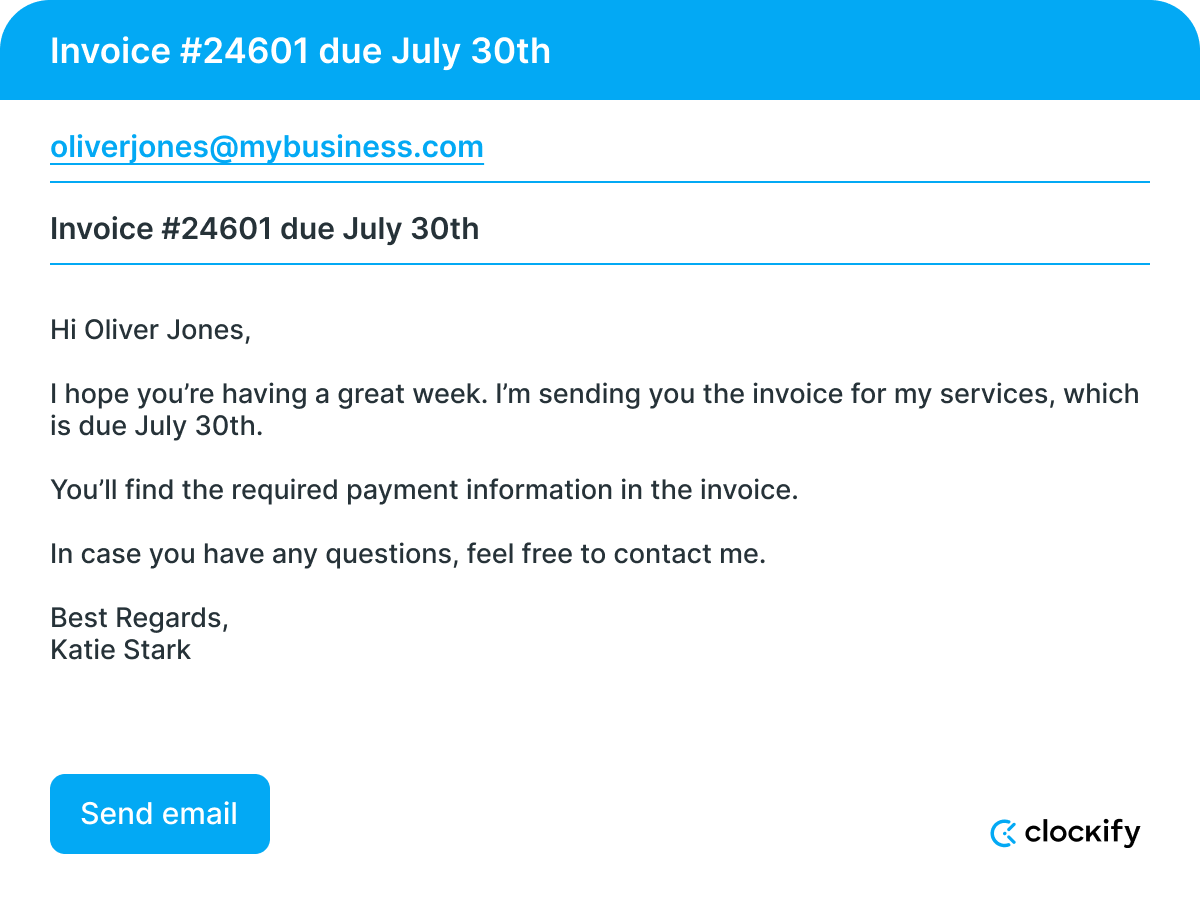
Also, try sending your invoice at least 2 weeks before the payment due date to ensure your client has enough time to gather and organize payment documentation needed when paying contractors. This way, you’ll minimize the chances of waiting to receive payment for too long or having to remind clients about outstanding payments.
While drafting an email that you’ll send one week before the payment due date, try keeping your tone:
Additional tips for writing your payment request email
You don’t need to ask for payment directly in the second email — you just need to make sure your client knows your payment terms and basic information beforehand.
This way, you’ll position yourself as a professional who regularly tracks payments and sends payment follow-up emails if the client doesn’t pay on time.
Take a look at an example of the payment request email you can send to your client:

When the day of the payment comes, and you still haven’t been paid, you have to act on it.
But how do you write a strong email for a payment?
Well, it’s best to go with a payment request email reminder.
You should make sure to write this one while remaining:
Additional tips for writing your payment request email
Since this is just another polite email reminder, you should maintain a completely friendly tone with your client — the bill isn’t overdue yet.
The most effective choice is to make this email clear and concise — with a direct call to make the payment to meet today’s payment deadline.
Here’s how you can write this payment request email reminder:
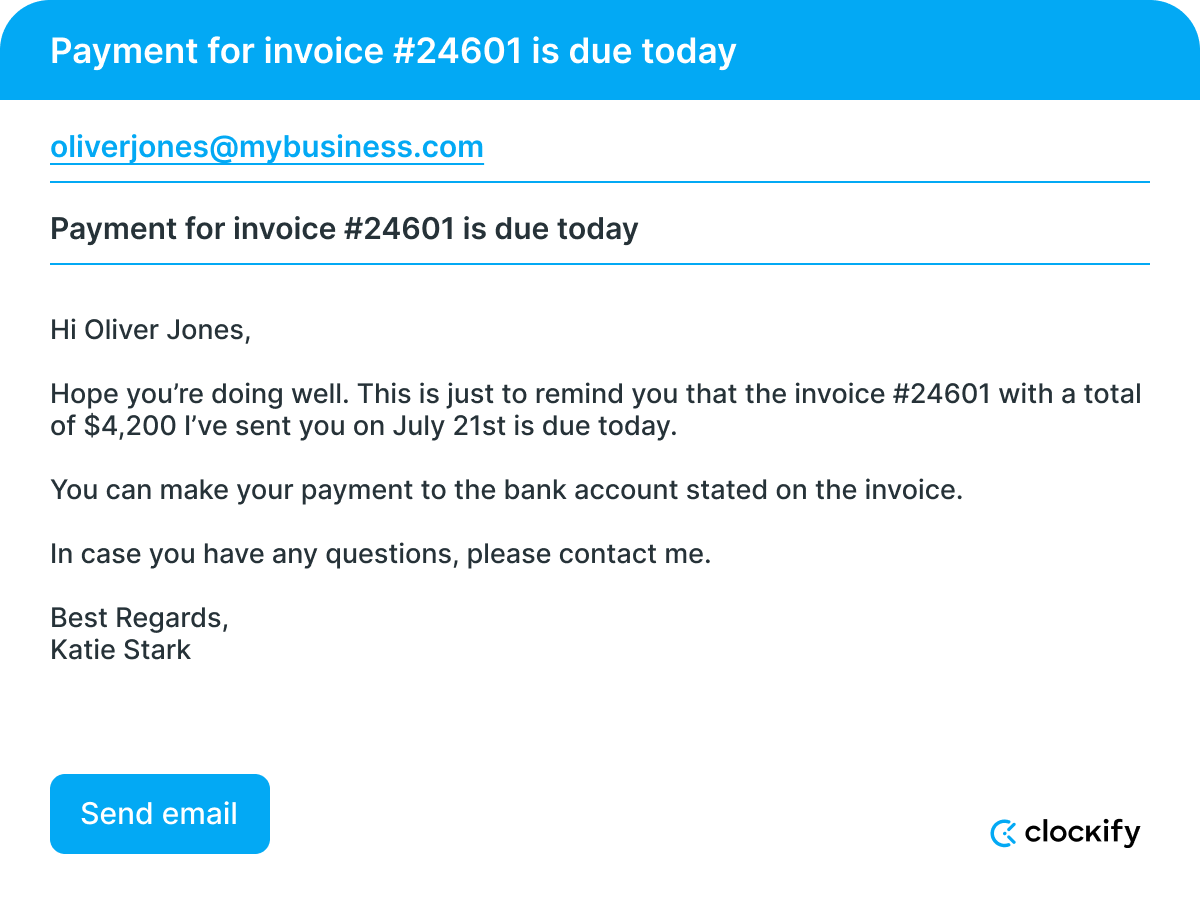
A whole week has passed, and now you’ve got an unpaid invoice to handle. It’s time for another payment request email reminder. When writing this one, you should:
Additional tips for writing your payment request email
This is your first email about the invoice being overdue — so you’ll need to maintain a firmer tone and include a straightforward CTA.
You should also make sure to repeat the basic invoice information, such as:
You’re still giving your client the benefit of the doubt, so make sure you also include a copy of the original invoice in the attachment. Perhaps you’ll find out the attachment you previously sent was faulty, and the client did not receive the invoice.
This payment email reminder can sound something like this:

It’s now 2 weeks past the payment due date, and you’re probably getting anxious. Remember that remaining professional and calm is necessary even at this point.
So, how do you write this payment email reminder? Consider the following:
Additional tips for writing your payment request email
As you send your second direct reminder email telling the client their payment is overdue, you’ll need to be even firmer and more direct.
A clear call to action and asking the client to confirm they received the invoice email will lessen the chances that the client will ignore the email.
Although the benefit of the doubt is mostly gone by now, sending another attachment of the invoice will serve as another reminder to your client — regardless of their reason for not replying.
This is what a good payment email reminder looks like:
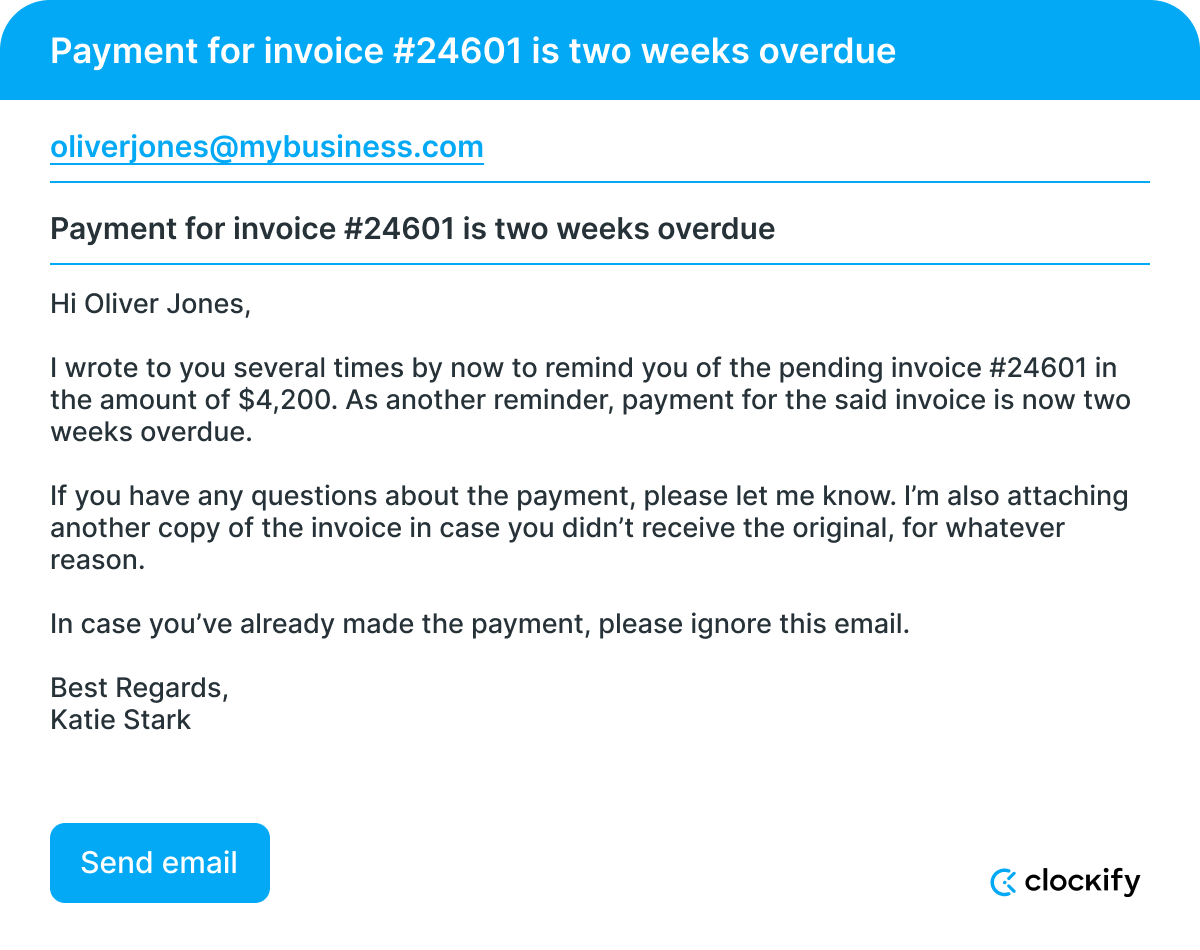
Before you know it, it’s already one month after the payment due date. You should plan for another payment request email reminder and make sure to:
Additional tips for writing your payment request email
Considering that you’ve already sent a couple of invoice emails that have been completely ignored, you should take a firmer and tougher approach with this requesting payment letter.
Of course, remaining as professional and polite as possible should still be your top priority.
In case your business has a specific policy for handling late payments (such as an additional fee), you could state that in your payment request email, too.
However, avoid turning to threats and direct accusations — you’ll risk seeming unprofessional and ruining your reputation. Moreover, you’ll be less likely to get paid.
An efficient way to send this final payment email reminder would be something like this:
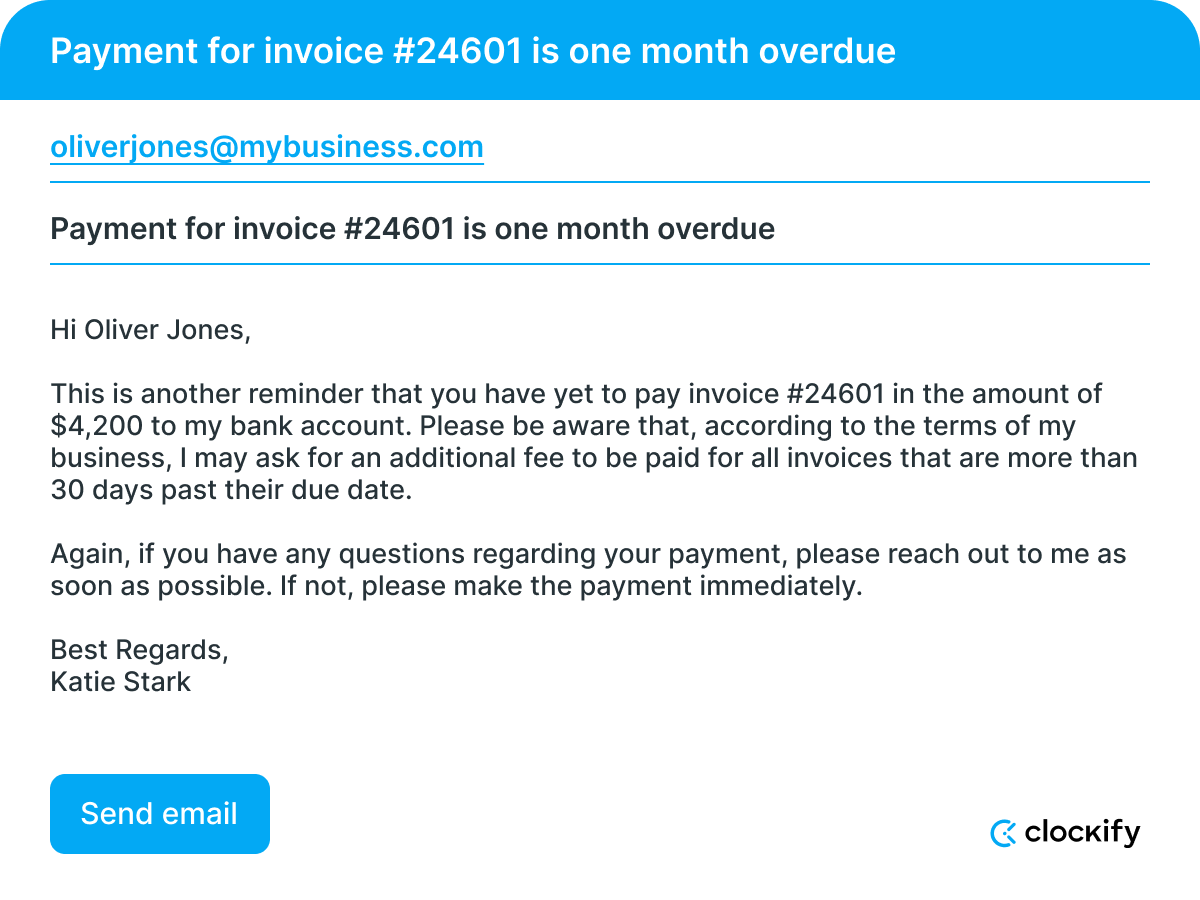
It’s easy to give in to frustration when you’re waiting for a payment to be issued.
Still, it’s essential not to let your emotions overwhelm you and to keep sending professional and polite reminders to your clients.
To help you avoid mistakes when sending our payment request follow-up emails, we crafted a few bad examples.
Take a look at what you shouldn’t do when asking for payment from your clients.
💡 Clockify Pro Tip
Remaining professional in a business environment goes hand in hand with handling your emotions well. Here’s how you can do it:
You sent a payment request reminder to your client before the due date and wrote the following:
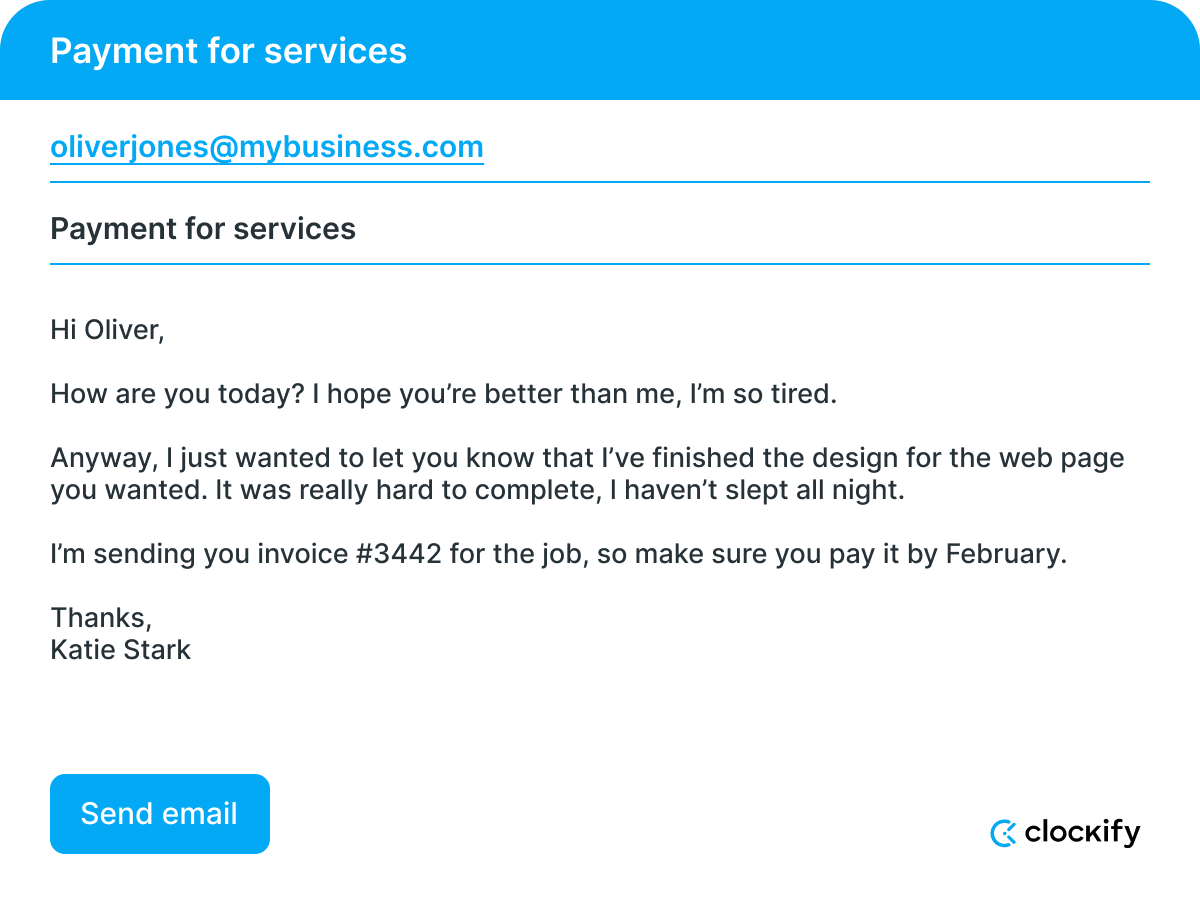
What’s wrong with this payment request email?
Instead of dispatching a vague email containing personal information unrelated to your subject, try being as clear and direct as possible.
After a brief greeting, you should quickly state the purpose of your email — your payment request.
Your client didn’t pay you even though you agreed on a deadline. You’ve decided to write them an email reminder sometime after the due date. You write something like this:
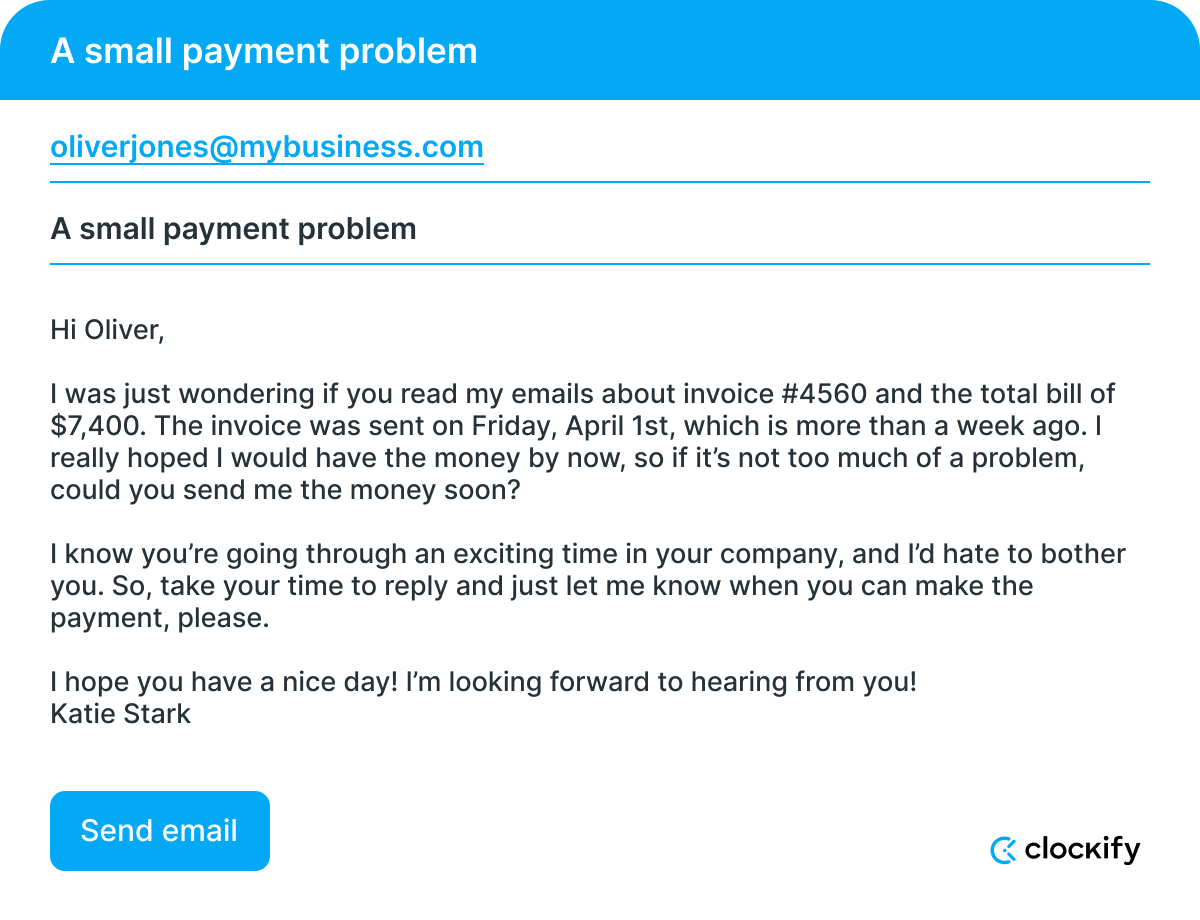
What’s wrong with this payment request email?
When composing a payment request email, try to come to the point right at the beginning of your email. Make sure to include a clear subject line and an explicit call to action.
It’s been a month since you finished that project and still no money? You’re so angry you can’t even think straight. You send out the following email:
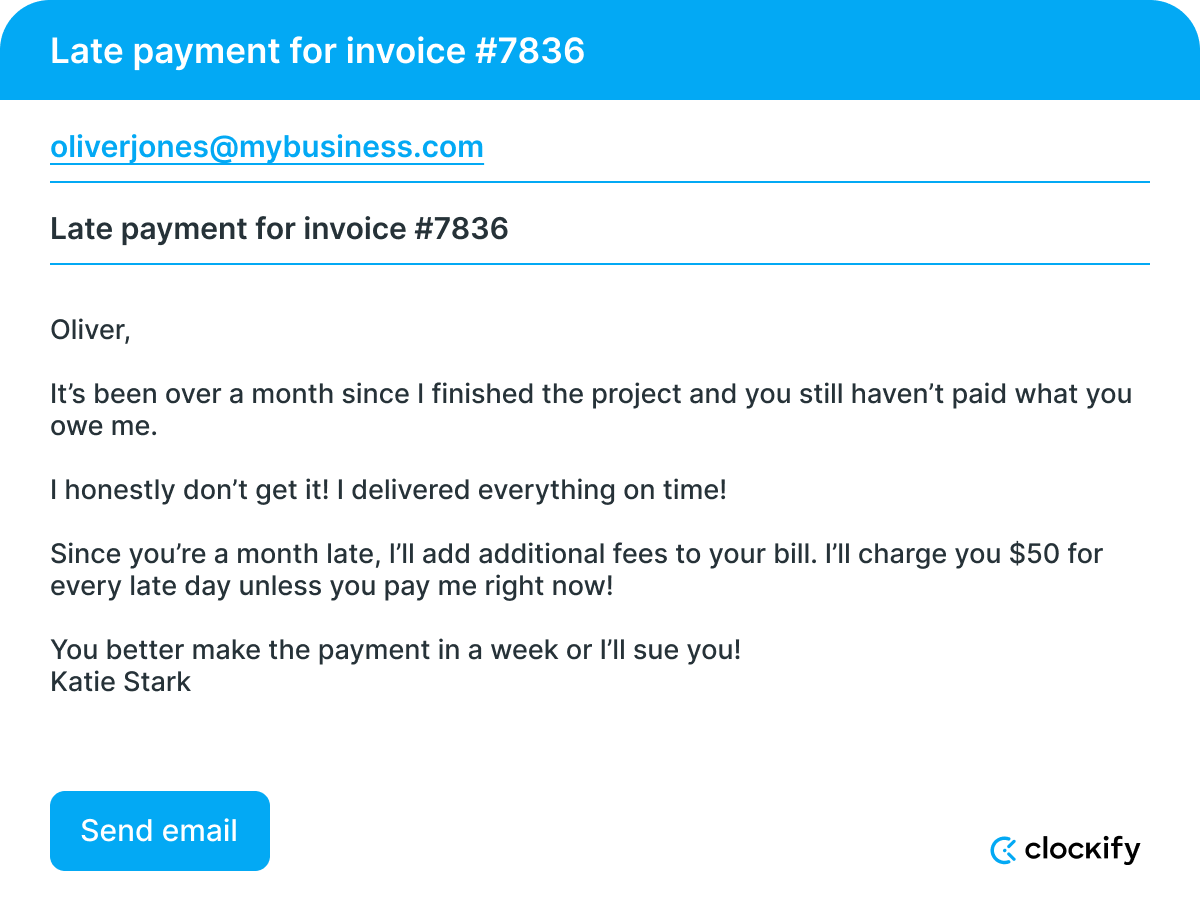
What’s wrong with this payment request email?
Even if you’ve decided to pursue legal action against your client, threatening them is never a solution, and it could potentially even backfire on you.
It’s always better to try to remain as polite and professional as possible, regardless of the time you’ve been waiting for their response.
In case asking for payment via email did not end up with a response, your second best option is reaching out to your client over the phone.
Depending on the situation or your preferences, there are two things you can do:
Here’s how you can finally set your records straight.
When talking to the client over the phone, you should make sure to:
If in doubt about what to say to your client, you can open up in the following way:
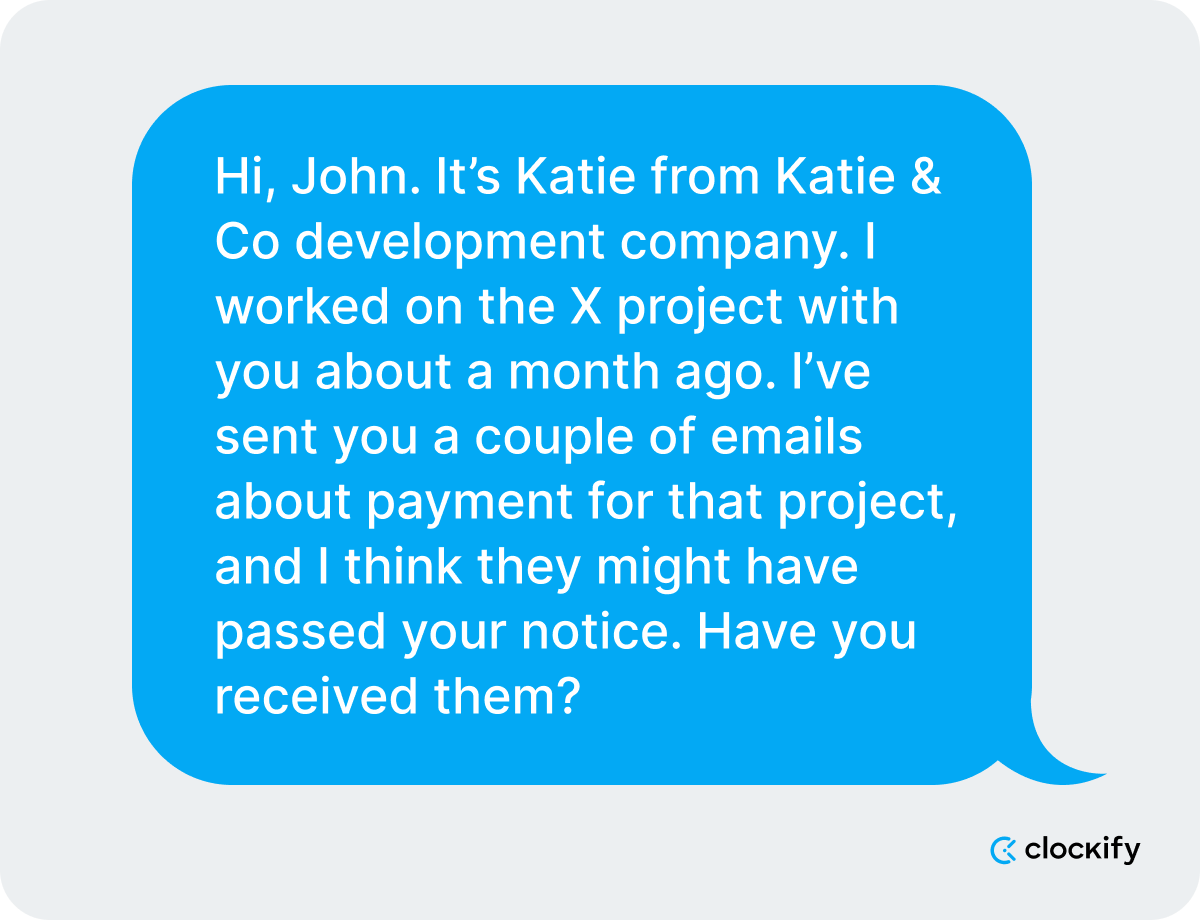
No matter how the conversation continues from there, you’re likely to get some answers to your questions. You may even find that:
Whatever the reason may be, you’ll be more likely to learn about it if you talk with your client over the phone.
You’ll also be able to polish out the details for finalizing that payment in a more brisk manner than you’d be able to via email — probably because you won’t have to wait long for the reply.
If you’re really out of luck, your client may not answer the phone. The reasons for this can be different:
In any case, if you already have your client’s number, you should text them. This might turn out to be the fastest and easiest way to get in touch.
You can send something like this:
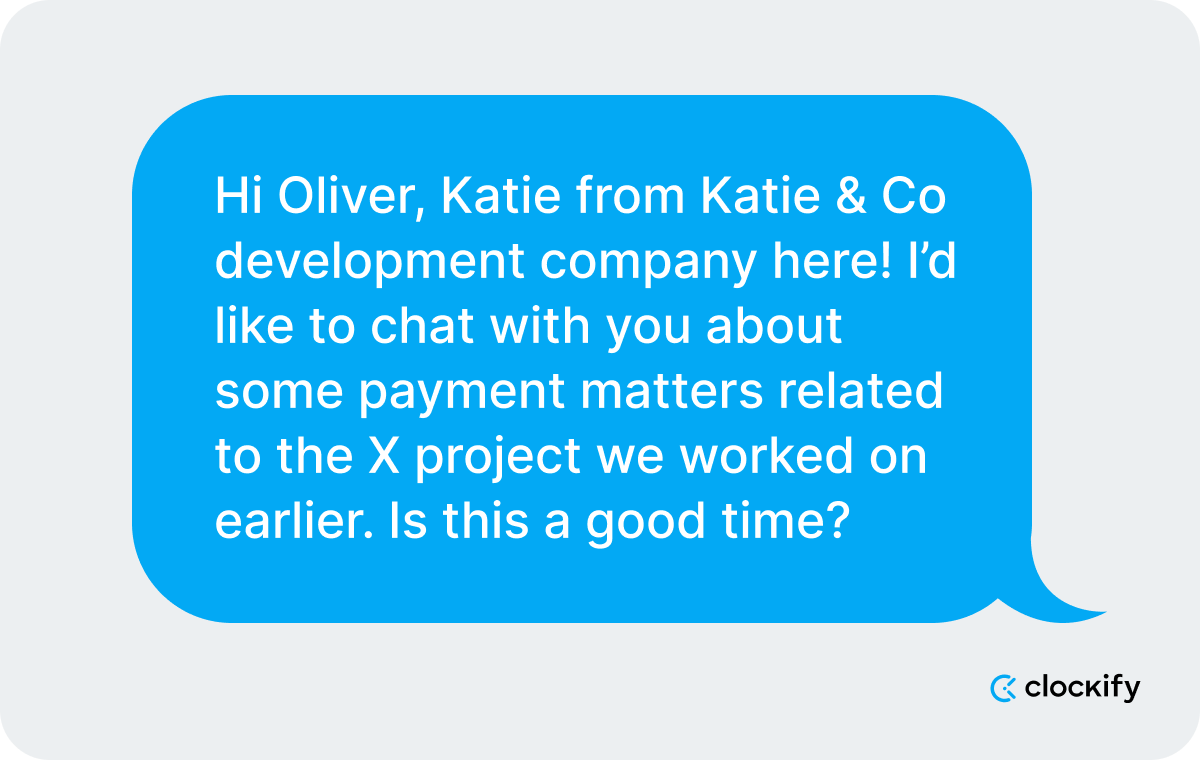
When you choose to send a text message, you’ll give your client more time to prepare and respond. Moreover, this way you’ll help clients who don’t like to talk over the phone feel more at ease.
Chances are, once your client realizes who you are, you’ll probably receive a call from them or a message indicating when it would be a good time to call back.
Up until now, you’ve probably mastered how to ask for payment from a client.
However, if you’d like to prevent having to handle a bunch of unpaid invoices in the first place, taking steps in advance might be the smartest way to go.
After all, taking precautions seems like a better tactic than chasing after your clients when you’ve finished and delivered the project.
Here are a few additional tips and strategies to help you get paid on time.
💡 Clockify Pro Tip
Finding a common ground with your client or clients can sometimes be hard. To help you cross that bridge, we provide you with some useful tips in our article:
Getting paid on time can be a lot easier if you always have precise and transparent records of your work. This way, you can always prove that:
Your best option for achieving full transparency and accountability with your clients, is to avoid relying on your memory and keeping all your records straight in a time tracker.
In Clockify, for example, regardless of whether you are a freelancer or an independent consultant, you can:
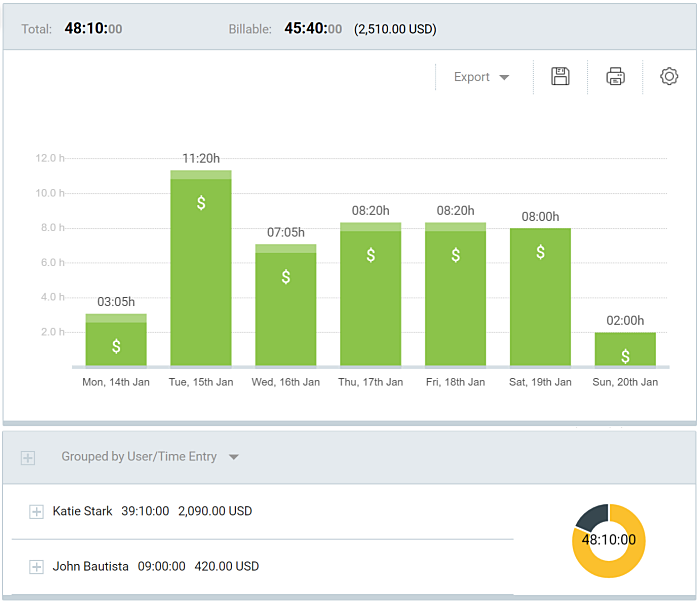
In addition to these features, Clockify also works as a free time clock app that will make clocking in and clocking out as effective as possible.

FREE FOREVER • UNLIMITED USERS
Free time tracker
Track the hours you spend working, across projects — for easy and accurate invoicing.

Using a time tracker to keep an eye on all your projects and tasks will definitely help you minimize the chances of not being paid on time.
💡 Clockify Pro Tip
If you’re new to the world of freelancing and you’ve just landed your first project, you need to be familiar with all the terms and processes related to your payment. Here’s a blog post to get you started:
Most of the time, it’s best to simply put your rights and obligations on paper.
Signing a legally binding contract may be a good way to steer clear of not being paid.
You might not have considered this the most crucial element in your work, but having a contract may help tip the scales in your favor.
When drawing a contract, you should make sure you include the following elements:
Even if the contract cannot guarantee the clients will pay you, it may still encourage them not to delay their payment for too long.
Finally, you can also consult a legal entity about what elements you should include in your contract to maintain professionality. This will also provide proof of everything you agreed upon with your client in case you have to turn to the law.
Asking for an advance is another great way to ensure getting paid once you finish the project. You can even include an advance deposit clause in your contract and let your clients know this is the way you do your business.
In essence, clients who are willing to pay part of the agreed amount in advance are the ones who are taking this entire collaboration seriously. They will most likely pay you in full at the end of the project, too.
However, clients who frown upon this section in your contract or downright refuse to sign it will probably bail on paying once you’ve completed the project. So, it’s best not to collaborate with them in the first place — it will save you both time and money.
Yet, if you still think that a hefty advance deposit might turn away first-time clients who may be wary of your work, you can provide them with an alternative. You can ask them to pay you smaller amounts of money when you reach certain project milestones.
💡 Clockify Pro Tip
If you agree on getting paid after you reach certain milestones, the best decision is to keep track of the entire project from start to finish, and here’s exactly how you can do that:
To make the entire process of payment easier for both sides, it’s important that you find a suitable and reliable payment method.
Your chosen payment processor has to be:
For example, PayPal is an efficient, standard choice, but there are also other useful payment processors you can try out.
However, try to make your pick based on factors relevant to you and your clients, such as:
💡 Clockify Pro Tip
If you’re still struggling with finding a great payment processor, take a look at our blog posts for more information:
A professional-looking invoice will increase the chances of you getting paid. The great thing is that the market is packed full of invoicing apps you can use for this purpose.
Invoicing tools (or tools with invoicing features) help you organize and keep in order your due payments and invoices.
If you use Clockify to stay on top of your billable hours, you can send your invoice directly from the app as soon as you’ve checked off the last task on your list.
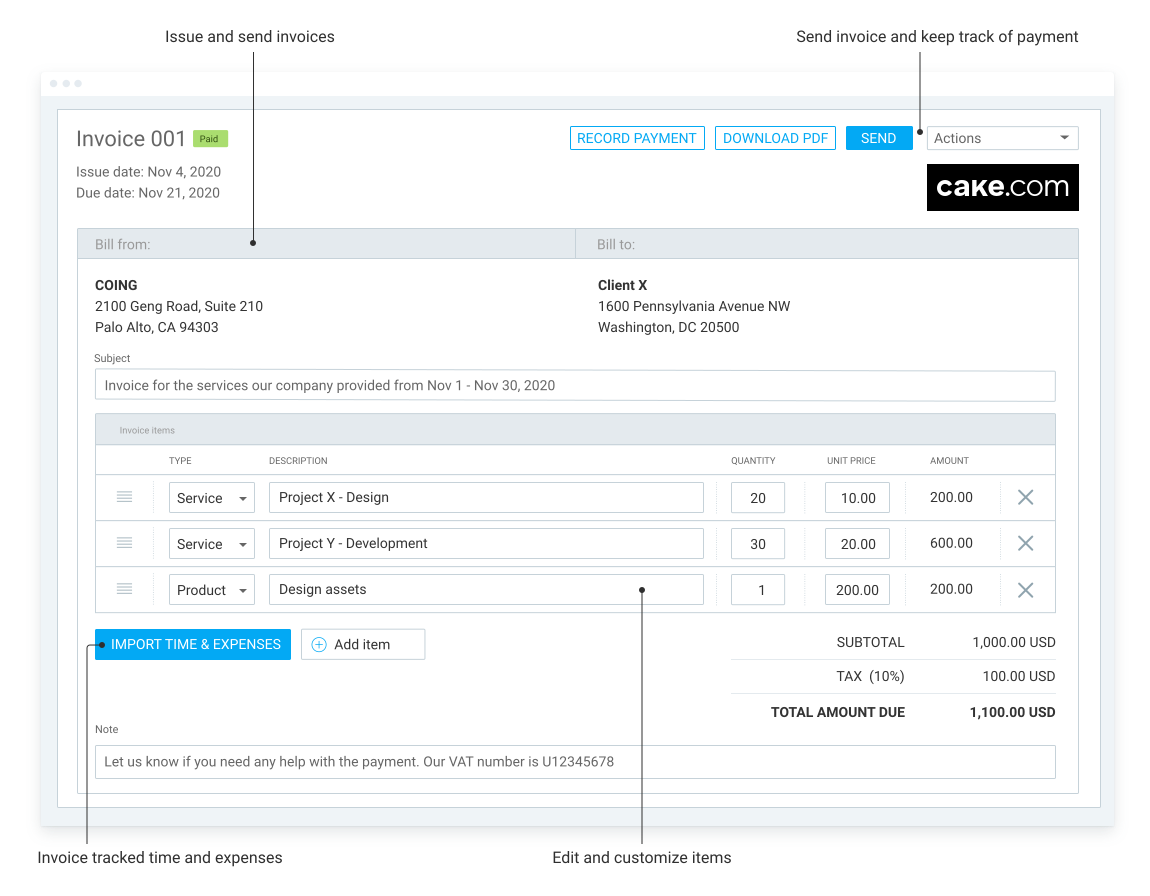
Also, Clockify comes packed with plenty of additional handy features, that can help you manage your targets, task rates, and more.
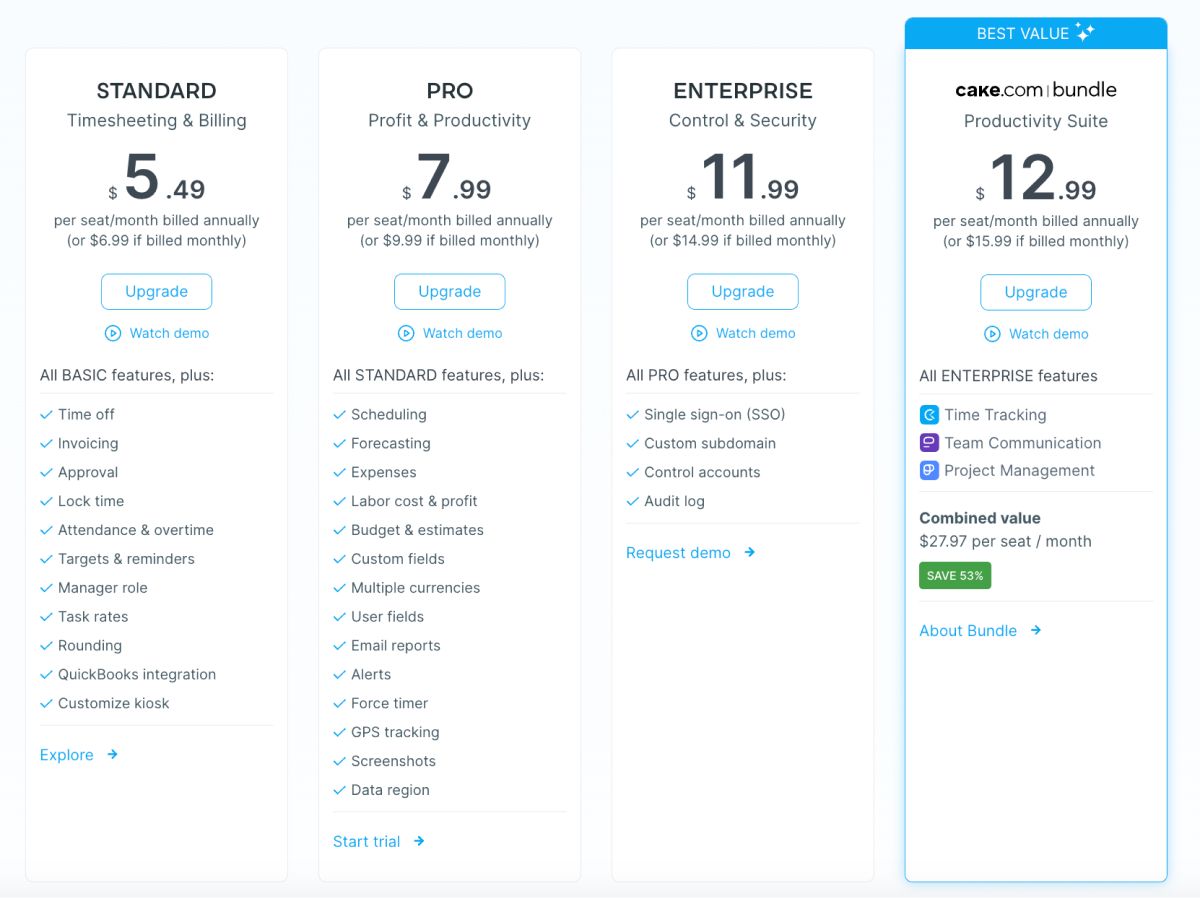
💡 Clockify Pro Tip
If you’ve decided to be a freelancer full-time, you might benefit from a few useful tips and start earning more than you already are:
Sometimes you could invest months in a project only to end up empty-handed because the client was not satisfied with the final outcome.
Even though this is not a legitimate reason not to pay for a service, if you haven’t drawn a legally binding contract beforehand, the time you invested could potentially go to waste.
To avoid such a situation, it’s always best to discuss every aspect of your project with the client upfront. Hop on a quick call, discuss all the milestones, deadlines, and goals of the project you’re about to take on and make sure to ask questions if any part of the deal sounds confusing.
Also, checking in with your client to keep them updated on your progress could help you avoid having to re-do your tasks if it turns out you weren’t exactly on the same page.
In case you’ve landed your job on a freelance platform, you might have had this payment option set up by default.
In a nutshell, a milestone payment is made once you’ve completed a certain stage of the project.
For example, if you are about to begin working on a 100-page translation, you could agree with your client on getting paid a certain amount out of the total budget once you send them the first 25 pages. After you’re done with the next 25 pages, the client issues the second payment, and so on.
This way, not only do you eliminate the potential misunderstandings regarding the final outcome of the project, but you also protect your time and prevent having to deal with missed payments.
💡 Clockify Pro Tip
Staying on top of all the payments while balancing multiple freelancing gigs can be a handful. Take a look at the apps that could make all those processes easier:
If you haven’t had a chance to work with them before, prior to taking on any work, try finding out more about your client.
A simple step such as a Google search could potentially let you in on your client’s reputation. You might even stumble across other freelancers’ reviews on social media who’ve worked with that particular client before and had to deal with outstanding payments.
Such information could save you the trouble of ever having to chase after outstanding payments.
Making sure you’ve inserted a watermark or limited access to your work before being fully compensated helps increase your chances of getting paid on time.
However, this might not always be possible depending on the type of work you do. Alternatively, you could combine this method with milestone payments or an advance deposit and only release a section of your work before you receive payment.

FREE FOREVER • UNLIMITED USERS
Free project time tracker
Track billable hours, create invoices, and analyze client profitability — with Clockify.

You’ve taken all the preventative measures and sent dozens of emails, but you still didn’t receive money for your services? Here’s what you could do next.
If you have tried everything under the sun to ensure you get paid for your work, and your client has given you no response, your next step could be to send a demand letter.
Most frequently used for resolving payment-related issues, a demand letter is a document that could help avoid taking a dispute to court.
In this case, it works as a more formal reminder than emails — think of it as a payment request letter.
If you are considering drafting a demand letter, make sure to include all the details and terms regarding the payment, such as:
Note: Even though the content of a demand letter is pretty straightforward, it’s always best to consult with a legal advisor before dispatching the letter. Clockify is not responsible for any losses or risks incurred should this example be used without further guidance from legal advisors.
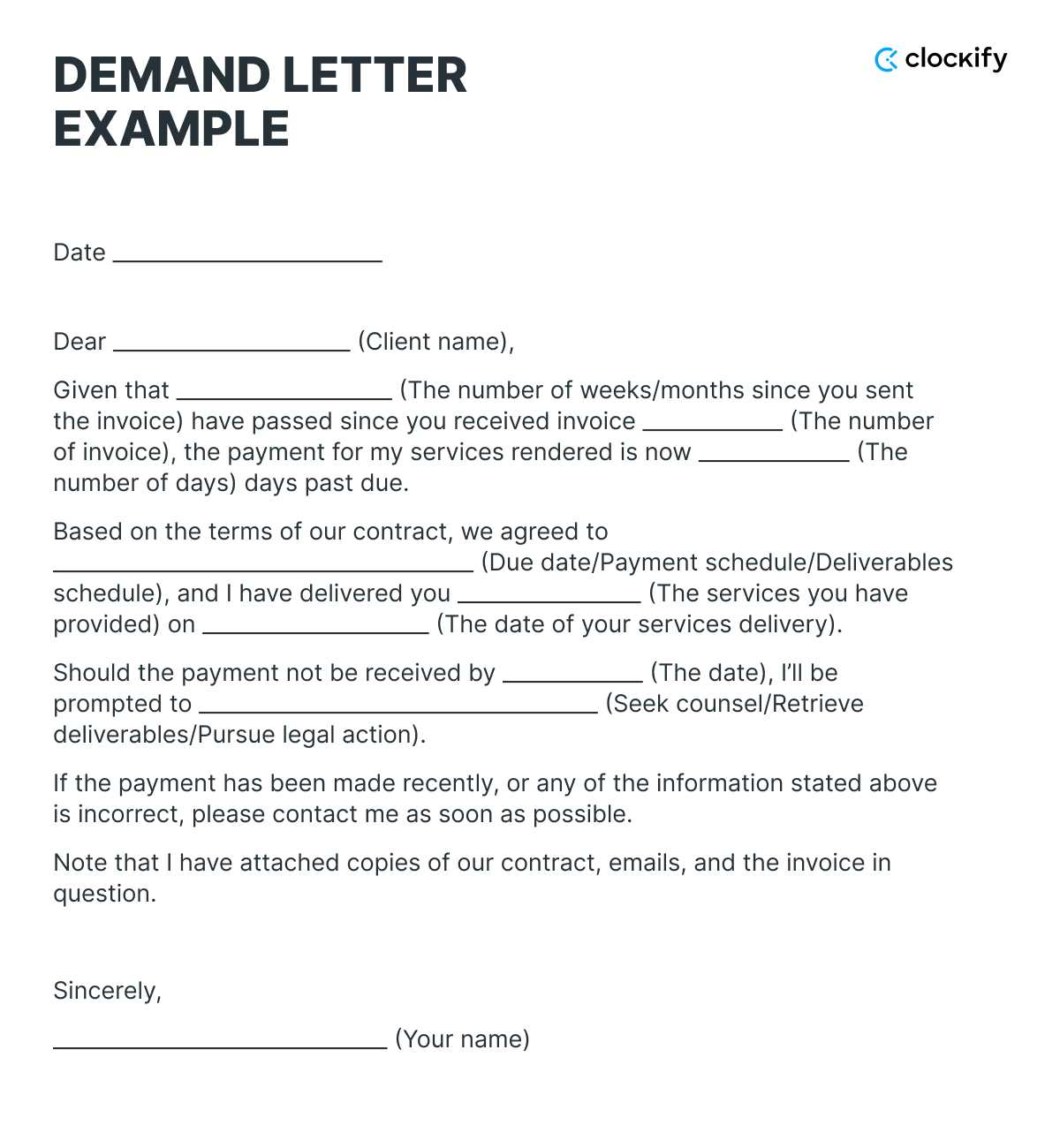
If the payment you’re owed outweighs the potential costs of seeking legal action, your next best shot is to consult with a lawyer.
They are the ones who can give you the best advice regarding your further action and help you decide whether pursuing a lawsuit would be worth investing more of your time and money.
Since you’ve reached the end of this article, it may be safe to assume that some of your clients may have breached the payment deadline. Understandably, you searched for the most polite and professional way to ask for payment.
But what is done is done.
To avoid such situations in the future, it may be best to:
Speaking of which, a project tracking system like Clockify lets you:
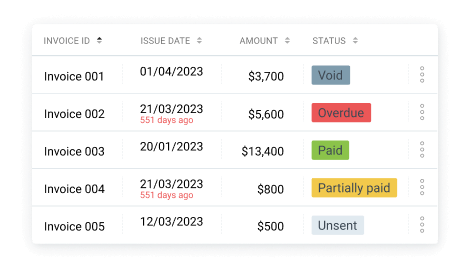
That way, you’ll know exactly who you need to (re-)ask for payment and who’s proven to be a reliable client. If we need to say it — you’ll save yourself some headaches.
By letting you monitor the progress of each of your tasks and create and manage invoices based on your tracked time, Clockify helps you stay on top of your completed projects at all times and minimize the chances of not being paid on time.

Natasa Milojevic is a writer, researcher, and admitted productivity and time management geek. Going over heaps of self-improvement techniques by night and testing them out by day, she is most frequently seen racing against the clock — so that you don’t have to.